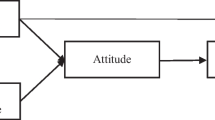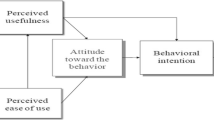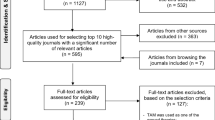Abstract
In the past, most studies used the technology acceptance model (TAM) to survey the subjective perception of users in using information technology. The usability test was also used to assess the ease of use of user interfaces. This study introduces a conceptual framework to explore the relationship between user’s beliefs of TAM and usability testing attributes. Usability testing was conducted on an eCampus learning system with a mobile device. TAM data was collected from the participants for analyzing a possible relationship. The findings of this study reveal that TAM results contradict the usability test results in certain areas. The focus of our proposed research model is supported from the causality between perceived ease of use and usability; however, the correlation between perceived usefulness and usability remains unclear.



Similar content being viewed by others
References
Adeoye B, Wentling RM (2007) The relationship between national culture and the usability of an e-learning system. Int J E-Learn 6(1):119–146
Bruner GC, Kumar A (2005) Explaining consumer acceptance of handheld Internet devices. J Bus Res 58(5):553–558
Calisir F, Calisir F (2004) The relation of interface usability characteristics, perceived usefulness, and perceived ease of use to end-user satisfaction with enterprise resource planning (ERP) systems. Comput Hum Behav 20(4):505–515
Chang HH, Wang IC (2008) An investigation of user communication behavior in computer mediated environments. Comput Hum Behav 24(5):2336–2356
Cheung W, Chang M, Lai V (2000) Prediction of Internet and World Wide Web usage at work: a test of an extended triandis model. Decis Support Syst 30(1):83–100
Cowen LL, Ball J, Delin J (2002) An eye-movement analysis of web-page usability. In: Proceedings of HCI 2002: People and Computers XVI—Memorable yet Invisible, London, pp 317–335
Davis FD (1989) Perceived usefulness, perceived ease of use, and user acceptance of information technology. MIS Q 13(3):319–340
Davis FD, Bagozzi RP, Warshaw PR (1989) User acceptance of computer technology: a comparison of two theoretical models. Manag Sci 35(8):982–1002
Dishaw MT, Strong DM (1999) Extending the technology acceptance model with task-technology fit constructs. Inf Manag 36(1):9–21
Fukuda R, Bubb H (2003) Eye tracking study on Web-use: comparison between younger and elderly users in case of search task with electronic timetable service. PsychNology J 1(3):202–228
Goldberg HJ, Kotval XP (1999) Computer interface evaluation using eye movements: methods and constructs. Int J Ind Ergon 24:631–645
Gulliver SR, Serif T, Ghinea G (2004) Pervasive and standalone computing: the perceptual effects of variable multimedia quality. Int J Hum Comput Stud 60:640–665
Henderson R, Divett MJ (2003) Perceived usefulness, ease of use and electronic supermarket use. Int J Hum-Comput Stud 59(3):383–395
Holzinger A (2005) Usability engineering methods for software developers. Commun ACM 48(1):71–74
ISO 9241-11 (1998) Ergonomic requirements for office work with visual display terminals (VDTs)—part 11: guidance on usability
Jacob RJK, Karn KS (2003) Eye tracking in human-computer interaction and usability research: Ready to deliver the promise. In: Hyona J, Radach R, Deubel H (eds) The mind’s eyes: cognitive and applied aspects of eye movements. Elsevier, Amsterdam, pp 573–603
Jasperson J, Cater PE, Zmud RW (2005) A comprehensive conceptualization of post adoptive behavior associated with information technology enabled work systems. MIS Q 29(3):525–557
Jiang J, Hsu M, Klein G, Lin B (2000) E-commerce user behavior model: an empirical study. Hum Syst Manag 19:265–276
Josephson S, Holmes ME (2002) Visual attention to repeated images on the World-Wide Web: another look at scanpath theory. Behav Res Methods Instrum Comput 34(4):539–548
Kaikkonen A, Kekäläinen A, Cankar M, Kallio T, Kanainen A (2005) Usability testing of mobile applications: a comparison between laboratory and field testing. J Usability Stud 1(1):4–16
Kjeldskov J, Stage J (2004) New techniques for usability evaluation of mobile systems. Int Hum Comput Stud 60(4):599–620
Klopping IM, McKinney E (2004) Extending the technology acceptance model and the task-technology fit model to consumer e-commerce. Inf Technol Learn Perform J 22(1):35–48
Koufaris M (2002) Applying the technology acceptance model and flow theory to online consumer behavior. Inf Syst Res 13(2):205–223
Kushniruk AW, Triola MM, Borycki EM, Stein B, Kannry JL (2005) Technology induced error and usability: the relationship between usability problems and prescription errors when using a handheld application. Int Med Inform 74:519–526
Lee YS, Hong SW, Smith-Jackson TL, Nussbaum MA, Tomioka K (2006) Systematic evaluation methodology for cell phone user interfaces. Interact Comput 18:304–325
Liu I-F, Chen MC, Sun YS, Wible D, Kuo C-H (2010) Extending the TAM model to explore the factors that affect intention to use an online learning community. Comput Educ 54(2):600–610
Martins LL, Kellermanns FW (2004) A model of business school students’ acceptance of a web-based course management system. Acad Manag Learn Educ 3(1):7–26
Moon JW, Kim YG (2001) Extending the TAM for a world-wide-web context. Inf Manag 38(4):217–230
Moore GC, Benbasat I (1991) Development of an instrument to measure the perceptions of adopting an information technology innovation. Inf Syst Res 2(3):192–222
Nielsen J (1993) Usability engineering. Morgan Kaufman, San Francisco
Öquist G, Goldstein M (2003) Towards an improved readability on mobile devices: evaluating adaptive rapid serial visual presentation. Interact Comput 15(4):539–558
Padilla-Melendez A, Garrido-Marrino A, Aguilla-Obra AR (2008) Factors affecting e-collaboration technology use among management students. Comput Educ 51(2):609–623
Parush A, Yuviler-Gavish N (2004) Web navigation structures in cellular phones: the depth/breadth trade-off issue. Int Hum Comput Stud 60:753–770
Poole A, Ball LJ (2005) Eye tracking in human-computer interaction and usability research. In: Ghaoui C (ed), Encyclopedia of human computer interaction. Idea Group, Pennsylvania, pp 211–219
Reuss E, Menozzi M, Büchi M, Koller J, Krueger H (2004) Information access at the point of care: what can we learn for designing a mobile CPR system? Int Med Inform 73:363–369
Roca JC, Chiu CM, Martínez FJ (2006) Understanding E-learning continuance intention: an extension of the technology acceptance model. Int J Hum comput Stud 64(8):683–696
Rubin J (1994) Handbook of usability testing: how to plan, design, and conduct effective tests. Wiley, New York
Russell MC (2005) Investigating contributions of eye-tracking to website usability testing. Wichita State University, Dissertation
Saadé R, Bahli B (2005) The impact of cognitive absorption on perceived usefulness and perceived ease of use in on-line learning: an extension of the technology acceptance model. Inf Manag 42:317–327
Song L, Singleton ES, Hill JR, Koh MH (2004) Improving online learning: student perceptions of useful and challenging characteristics. Internet High Educ 7(1):59–70
Taylor S, Todd PA (1995) Understanding information technology usage: a test of competing models. Inf Syst Res 6(6):144–174
Venkatesh V (2000) Determinants of perceived ease of use: integrating control, intrinsic motivation, and emotion into the technology acceptance model. Inf Syst Res 11(4):342–365
Venkatesh V, Davis FD (2000) A theoretical extension of the technology acceptance model: four longitudinal field studies. Manag Sci 46(2):186–204
Virzi RA (1992) Refining the test phase of usability evaluation: how many subjects is enough? Hum Factors 34(4):457–468
Wu JH, Wang SC, Lin LM (2007) Mobile computing acceptance factors in the healthcare industry: a structural equation model. Int J Med Inform 76:66–77
Yi MY, Jackson JD, Park JS, Probst JC (2006) Understanding information technology acceptance by individual professionals: toward an integrative view. Inf Manag 43(3):350–363
Yoon SY, Laffey J, Oh H (2008) Understanding usability and user experience of Web-based 3D graphics technology. Int J Hum Comput Interact 24(3):288–306
Zhang D, Adipat B (2005) Challenges, methodologies, and issues in the usability testing of mobile applications. Int J Hum Comput Interact 18(3):293–308
Acknowledgements
This research is supported by the National Science Council of the Republic of China under Grant No. NSC 99-2218-E-164-001.
Author information
Authors and Affiliations
Corresponding author
Rights and permissions
About this article
Cite this article
Lin, CC. Exploring the relationship between technology acceptance model and usability test. Inf Technol Manag 14, 243–255 (2013). https://doi.org/10.1007/s10799-013-0162-0
Published:
Issue Date:
DOI: https://doi.org/10.1007/s10799-013-0162-0




